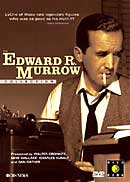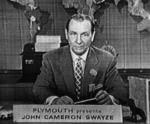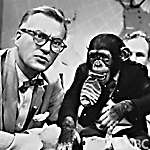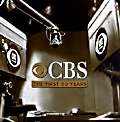NEWS SHOWS
See It Now
Meet the Press
NBC News
Today
CBS News
TV NEWS SHOWS
The primary source of news in the Fifties was newspapers and magazines. To view an event, people relied on MOVIETONE NEWS. These news segments played before every movie and were the best way to actually see what went on. Your “newsreel camera” was often the “most complete reporter.” MOVIETONE NEWS had camermen all over the world capturing footage of breaking stories.
But television would soon offer some strong competition.
We Interrupt This Broadcast: The Events That Stopped Our Lives…from the Hindenburg Explosion to the Attacks of September 11
BOOK and CD
See It Now
9/11/1951 – 4/7/1958 CBS
30 minutes
Black and White/Color
Edward R Murrow, anchor
Fred W. Friendly and Edward R. Murrow, producers
See It Now pioneered many features which now seem synonymous with news reporting.They were the first to use their own footage and not newreel film. They introduced the use of field producers. Interviews were not rehearsed.
On a split screen, viewers of the first installment could see both the Golden Gate and Brooklyn Bridges – spanning the continent in a single moment. This was the first live commercial coast to coast broadcast.
For seven years Murrow, with cigarette smoke swirling about him, let Americans see the world from their TV screens.
Murrow was the first commentator to publicly condemn Senator Joseph McCarthy. Although many of his stands were courageous, he attracted controversy and this often worried sponsors.
Passings
Edward R. Murrow died in 1965 of brain cancer and Fred Friendly in 1998.![TV News Shows [EDWARD R. MURROW]](https://assets.fiftiesweb.com/murrow1.jpg)
Edward R. Murrow
The Edward R. Murrow Collection
Meet the Press
11/6/1947 –
30 minutes until 9/13/1992, then 60 minutes NBC
Black and White/Color
Created by Martha Rountree
Moderators:
Lawrence E. Spivak (1947-1975), Bill Monroe (1975-1984), Marvin Kalb (1984-1987), Chris Wallace (1987-1988), Garrick Utley (1988-1991), Tim Russert (1991- 2008)
“American Mercury Magazine” editor Lawrence E. Spivak started the show in 1945 on radio as a nice promotion for his magazine.Who knew it would become the longest running network show?
Martha Rountree, the original creator sold her interest to Spivak in 1953. He left the show in 1975. His last guest was President Gerald R. Ford, the first incumbent President to appear.
Little has changed over the years. A guest is interviewed by the moderator and panelists.
Passings
Lawrence Spivak died in 1994 of congestive heart failure, Garrick Utley died in 2014 of prostate cancer and Tim Russert died of a heart attack in 2008
NBC News
2/16/1948 –
15 minutes until 9/9/1963, then 30 minutes
Black and White until 1966, then Color
Anchors:
John Cameron Swayze (1948-1956), Chet Huntley (1956-1970), David Brinkley (1956-1979), John Chancellor (1971-1982), Tom Brokaw (1982-2004), Roger Mudd (1982-1983)
It started as the Camel Newsreel Theatre. Camel, as in the cigarettes.Lasting only ten minutes, the show featured John Cameron Swayze and the Movietone Newsreels. Later it expanded to fifteen minutes and Swayze narrated the news. In 1954 the now Camel News Caravan broadcast the first network news show in color, though this did not become a regular thing until 1965.
Eisenhower was the first presidental candidate to utilize television. Both the 1952 and 1956 conventions received network coverage.
NBC had paired a couple of fellows as anchors for these conventions who seemed to click. The partnership of Chet Huntley and David Brinkley was the stuff from which legends are formed. 1956 saw the beginning of the Huntley-Brinkley Report, a 15 minute nightly news program, the first of its kind. (It expanded to 30 minutes in 1963.)The Huntley-Brinkley Report was the top rated news program for most of its 14 year life.
After Huntley departed in 1970, the show was renamed the NBC Nightly News.
Passings
Chet Huntley died in 1974 of lung cancer, John Cameron Swayze in 1995, John Chancellor in 1996 of stomach cancer.Goodnight David, Goodnite Chet (Wav)(23K)

John Cameron Swayze

David Brinkley
Today
1/14/1952 – NBC
2 hours, then 3 hours
Black and White/Color
Sylvester L . Weaver, Creator (Signourney Weaver’s father)
Hosts:
Dave Garroway (1952-1961), John Chancellor (1961-1962), Hugh Downs (1962-1971), Barbara Walters (1963-1976), Frank McGee (1971-1974), Jim Hartz (1974-1976), Tom Brokaw (1976-1981), Jane Pauley (1976-1989), Bryant Gumbel (1982-1997), Katie Couric (1991-), Matt Lauer (1997-)
The accomplishments are many. First early morning show. Longest running daytime series. Most hours on the air. But nobody would have guessed that in the beginning.
The Today Show was one of many creative endeavors of Sylvester L. “Pat” Weaver (Your Show of Shows, Tonight, Wide, Wide World). He never figured people would watch the entire show, so he constructed it to allow for folks getting ready for work and school.
The original team was host Dave Garroway, sports by Jack Lescoulie and Jim Fleming read the news until 1953 when he was replaced by Frank Blair. From inception, the show has the glass window to view the streets of New York.
Early results weren’t promising and they decided to make the show more entertaining. They added a chimpanze by the name of J. Fred Muggs, who became a popular star in his own right.
Dave Garroway’s famous signoff was “Peace.”
The early years also featured a “Today Girl” whose main job was to look good. The first of these, Estelle Parsons, left to pursue an acting career. The “Today Girl” doesn’t mature until they hire Barbara Walters in 1963. She expanded not only the position but broke barriers to women in journalism.
Although faces have come and gone, the format remains about the same. And the Today Show endures.
Passings
Dave Garroway committed suicide in 1982, Frank McGee died of cancer in 1974, John Chancellor in 1996 of cancer, and Sylvester L. Weaver in 2002.
Dave Garroway

Dave Garroway
and J Fred Muggs
CBS News
5/3/1948 –
15 minutes until 9/2/1963, then 30 minutes
Black and White until1966, then Color
Anchors:
Douglas Edwards (1948-1962), Walter Cronkite (1962-1981), Dan Rather (1981-), Connie Chung (1993-1995)
The glory days for CBS were the Cronkite years. Voted the “Most Trusted Man America” the WWII veteran correspondant set the standard as both managing editor and anchor of the CBS News.
When people think back to hearing the news of Kennedy’s assassination, they see and hear Cronkite. (CBS was first to report the shooting but not the death.) Cronkite’s negative coverage live from View Nam was considered a turning point in American public opinion of the war.
By the time Dan Rather takes over, corporate policy had changed and the succeeding years were troubling.
As Cronkite always said in his signature closing, “that’s the way it is…”
Passings
Douglas Edwards died in 1990
Walter Cronkite died in 2009 at 92![TV News Shows [WALTER CRONKITE]](https://assets.fiftiesweb.com/cronkit2.jpg)
Walter Cronkite

Cronkite interviews Kennedy
CBS: The First 50 Years – CD
Has Cronkite’s final broadcast
